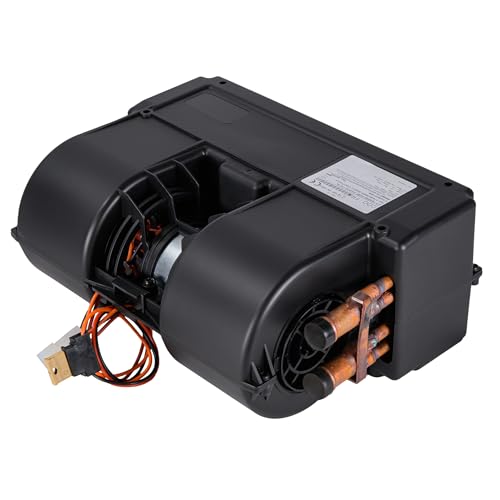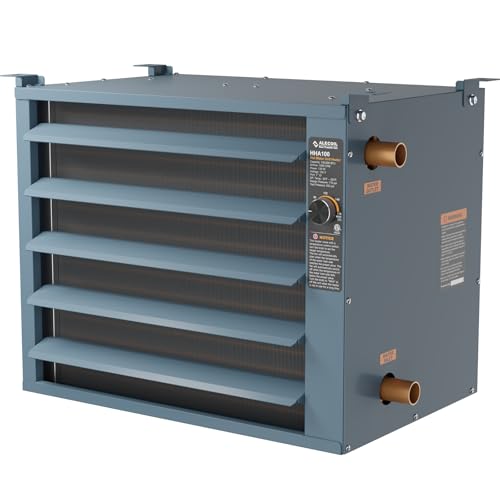Choosing the right marine hydronic heater keeps cabins warm, protects engines and prevents freezing in bilges. Below is a concise comparison of five relevant products suitable for different marine hydronic needs, from water heaters to coolant-driven cabin heaters and compact bilge protection.
| Product | Type | Primary Use |
|---|---|---|
| Kuuma 11-Gallon Water Heater | Tank Water Heater | Hot water supply for galley and shower |
| Maradyne Havasu Hydronic Automotive Heater | Coolant-Driven Cabin Heater | Under-dash cabin heating using engine coolant |
| ALECOIL 100,000 BTU Hydronic Hanging Unit | Water-To-Air Heat Exchanger | Heating large spaces from hot water source |
| Beacon Morris Twin-Flo III Kickspace Heater | Hydronic Kickspace Heater | Compact space heating using hot water loop |
| Xtreme 400W Marine Bilge Heater | Electric Bilge/Engine Compartment Heater | Freeze protection and engine compartment temperature control |
Content Navigation
- Kuuma 11-Gallon Water Heater With 120V Front Heat Exchange
- Maradyne Havasu Hydronic Automotive Heater 12V Under Dash
- ALECOIL 100,000 BTU Hydronic Hot Water Hanging Unit Heater
- Beacon Morris Twin-Flo III K84 Hydronic Kickspace Heater
- Xtreme 400W Marine Certified Bilge Heater
- Buying Guide: Choosing A Marine Hydronic Heater
Kuuma 11-Gallon Water Heater With 120V Front Heat Exchange

The Kuuma 11-gallon water heater is designed specifically for marine use to provide onboard domestic hot water. It integrates a front heat exchanger for engine-driven heating along with a 120V electric element for shore power or backup heating.
- Capacity: 11 gallons, suitable for small to mid-size boats with limited cabin demand.
- Dual Heat Sources: 120V electrical input (1500W) and front-mounted heat exchange port for engine loop heating.
- Marine Design: Compact silver tank designed for mounting in utility areas; intended for continuous duty typical of boat systems.
For vessels needing consistent hot water for galley and shower, this unit supports integration with engine coolant heat exchangers and shore power, enabling flexible heating strategies without major system complexity.
Maradyne Havasu Hydronic Automotive Heater 12V Under Dash

The Maradyne Havasu unit is a coolant-driven heater that uses engine coolant to supply cabin heat via a compact under-dash housing. While specified for automotive markets, its 12V operation and hydronic design make it applicable for boats with engine coolant loops.
Call 888-896-7031 for Free Local HVAC Quotes – Compare and Save Today!
- Coolant-Driven: Uses existing engine coolant to transfer heat without separate fuel or electrical heating loads.
- Installation: Under-dash mount with front panel louvers; includes 3 adjustable louvers for directional airflow.
- Performance: Claimed 20,000 BTU/hr and two-speed fan delivering up to 177 CFM for rapid cabin warm-up.
This model suits smaller cabins where space is limited and where tapping into the engine coolant loop is feasible. Consider plumbing runs, pump requirements and compatibility with marine cooling circuits during planning.
ALECOIL 100,000 BTU Hydronic Hot Water Hanging Unit Heater

The ALECOIL 100,000 BTU hanging unit is a water-to-air heat exchanger intended for large spaces heated from a hot water source. It features a temperature control switch that senses water inlet temperature to govern fan operation.
- Heat Transfer: Uses building hot water source to provide efficient air heating via a centrifugal blower.
- Temperature Control Switch: Automatic fan start/stop based on inlet water temperature to maintain setpoint and conserve energy.
- Airflow: Centrifugal blower for higher pressure and low noise, plus adjustable louver deflector for directional airflow.
While typically used for garages, warehouses or outdoor boiler systems, similar water-to-air exchangers are sometimes adapted for large masts, boat sheds or commercial marine spaces where a centralized hot water loop supplies multiple heat zones.
Beacon Morris Twin-Flo III K84 Hydronic Kickspace Heater

The Beacon Morris Twin-Flo III K84 is a compact kickspace hydronic heater delivering forced-air heat from a hot water loop. Its slim profile makes it suitable for floor-level installations where space is restricted.
Call 888-896-7031 for Free Local HVAC Quotes – Compare and Save Today!
- Design: Kickspace configuration for mounting under cabinetry or in confined enclosures common on boats.
- Airflow and Output: Twin-Flo fan design offering 72 CFM airflow and 8,400 BTU output for targeted zone heating.
- Application: Useful for localized cabin warming or for installing in heads/galley areas where concealed mounting is needed.
This kickspace heater is an option when a small zone needs hydronic heating sourced from a central engine or boiler loop and when minimal visible hardware is desired in living spaces.
Xtreme 400W Marine Certified Bilge Heater

The Xtreme 400W marine bilge heater is a compact electric PTC heater designed for engine compartments and bilge areas to provide freeze protection and maintain safe compartment temperatures during storage.
- Self-Regulating PTC Element: Turns on at ~40°F and off at ~55°F, maintaining consistent compartment temperature for freeze protection.
- Durability: Anodized casing, sealed electronics and waterproof 58 CFM fan allow flexible mounting orientations.
- Applications: Engine compartments, bilges, under-RV bellies, well houses and small enclosed cabins for winterization and storage protection.
For vessels without a hydronic loop or for seasonal freeze protection, an electric bilge heater provides a simple, low-installation-risk solution that complements hydronic systems focused on living-space heating.
Buying Guide: Choosing A Marine Hydronic Heater
Selecting the right marine hydronic heater requires aligning system type, vessel constraints and heating goals. Below are key considerations and comparison perspectives.
Heat Source And Compatibility
Engine Coolant vs. Hot Water Loop: Determine whether the heater will use engine coolant (closed-loop) or a separate hot water/boiler circuit. Engine coolant-driven units like under-dash hydronic heaters leverage waste heat but require plumbing into the engine cooling system and integration with coolant pumps.
Electrical Backup: Many marine water heaters include electric elements for shore-power or backup heating. Confirm available voltage and shore-power capacity before specifying an electrical element.
Intended Use And Capacity
Domestic Hot Water vs. Space Heating: Tank heaters (Kuuma) supply domestic hot water for galley and showers and are sized by gallon capacity. Space heaters (kickspace, under-dash, hanging exchangers) are rated by BTU and CFM for cabin heating.
Zone Requirements: Identify how many zones need heat and the distribution method—forced-air units move warm air quickly, while radiators or convectors provide passive warmth.
Footprint And Mounting Constraints
Boats have limited space. Kickspace and under-dash heaters excel where cabinetry or dash space exists. Hanging exchangers and larger units require overhead or utility spaces. Verify dimensions and mounting orientation allowances.
Corrosion And Marine Durability
Select components with marine-grade materials, corrosion-resistant casings and sealed electronics. Equipment mounted in bilges or engine rooms should tolerate moisture and occasional spray.
Control And Safety Features
Thermostats and Auto Controls: Look for thermostat control, automatic fan start/stop tied to inlet temperature, and over-temperature protection. Self-regulating PTC elements offer safe automatic cycling for bilges.
Alarms and Sensors: For critical systems, low/high-temperature alarms and remote sensors provide added protection and monitoring while away from the vessel.
Integration And Plumbing Considerations
When tying into engine coolant loops, ensure proper heat exchanger sizing, check for coolant isolation needs, and include air eliminators, isolation valves and a suitable pump rated for continuous duty. For tank heaters, confirm exchanger ports and hose fittings match existing plumbing standards.
Power Availability And Efficiency
Hydronic systems that use engine heat are fuel-efficient underway, while electric elements depend on shore power capacity. Evaluate runtime expectations, power budgets and whether to include thermostatic control to reduce runtime and energy consumption.
Maintenance And Serviceability
Consider access for routine maintenance: flushing, anode replacement for tanks, blower access for forced-air units and fan service for bilge heaters. Readily available replacement parts and documented marine installations reduce long-term service costs.
Comparison Perspectives
- Small Coastal Cruiser: Prioritize compact under-dash or kickspace hydronic heaters that use engine coolant and fit tight spaces.
- Cruise Trawler Or Liveaboard: Larger tank heaters with heat exchangers and distribution systems provide both domestic hot water and space heating when integrated with a boiler or engine loop.
- Winter Storage/Freeze Protection: Electric marine bilge heaters with self-regulating PTC elements offer low-effort freeze protection for engine compartments and bilges.
- Workshop, Shed, Or Large Covered Spaces: Water-to-air hanging units are suitable where a centralized hot water source serves large volumes, but consider marine-specific mounting and corrosion protection if used near water.
When selecting components, match the product’s stated features—capacity, CFM, BTU output, control options and mounting style—to your vessel’s layout and operational profile. Consult a marine HVAC technician for final sizing, plumbing and safe integration with engine cooling systems.
Tips for Getting the Best HVAC Prices
- Prioritize Quality Over Cost
The most critical factor in any HVAC project is the quality of the installation. Don’t compromise on contractor expertise just to save money. - Check for Rebates
Always research current rebates and incentives — they can significantly reduce your overall cost. - Compare Multiple Quotes
Request at least three estimates before making your choice. You can click here to get three free quotes from local professionals. These quotes include available rebates and tax credits and automatically exclude unqualified contractors. - Negotiate Smartly
Once you've chosen a contractor, use the proven strategies from our guide — How Homeowners Can Negotiate with HVAC Dealers — to get the best possible final price.
